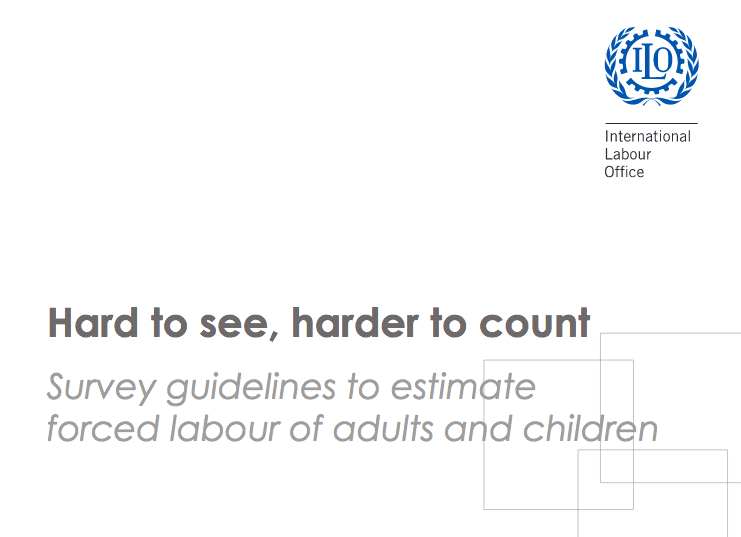
Survey Guidelines to Estimate Forced Labor of Adults and Children
ILO global estimates on child and forced labour have focused a spotlight on these persistent and severe violations of the human rights of children and adults. The magnitude of forced labour, estimated to affect at least 20.9 million people, of whom about a quarter are children, has served to demonstrate the urgency of action to address the needs of these most vulnerable workers, and prevent others from falling prey to such exploitation. But the estimates have also highlighted the critical need for sound statistics at national level. Criminal phenomena such as forced labour present obvious measurement challenges; conventional survey instruments are often ill-equipped to capture those child and adult workers concealed in hidden workshops, or toiling in fields under a burden of debt. Human trafficking can also be regarded as forced labour, and these guidelines can be used to measure the full spectrum of human trafficking abuses or what some people call “modern-day slavery”. The only exceptions to this are cases of trafficking for organ removal, forced marriage or adoption, unless the latter practices result in forced labour.
Action to address child labour and forced labour lies at the heart of the ILO’s decent work agenda, guided by ILO standards on these subjects. The International Programme on the Elimination of Child Labour (IPEC) has, since 1992, worked to eradicate child labour in all parts of the world. In 1998, ILO member States adopted the Declaration on Fundamental Principles and Rights at Work, thereby committing themselves to respect, promote and realise freedom of association and the right to collective bargaining, and the elimination of forced labour, child labour and discrimination at work. The International Labour Office, for its part, committed itself to assist member States in their efforts. Shortly thereafter, the Programme to Promote the Declaration was established and, in 2001, a Special Action Programme to combat Forced Labour (SAP-FL) was created as part of this programme.
11ForewordILO global estimates on child and forced labour have focused a spotlight on these persistent and severe violations of the human rights of children and adults. The magnitude of forced labour, estimated to affect at least 20.9 million people, of whom about a quarter are children, has served to demonstrate the urgency of action to address the needs of these most vulnerable workers, and prevent others from falling prey to such exploitation. But the estimates have also highlighted the critical need for sound statistics at national level. Criminal phenomena such as forced labour present obvious measurement challenges; conventional survey instruments are often ill-equipped to capture those child and adult workers concealed in hidden workshops, or toiling in fields under a burden of debt. Human trafficking can also be regarded as forced labour, and these guidelines can be used to measure the full spectrum of human trafficking abuses or what some people call “modern-day slavery”. The only exceptions to this are cases of trafficking for organ removal, forced marriage or adoption, unless the latter practices result in forced labour.Action to address child labour and forced labour lies at the heart of the ILO’s decent work agenda, guided by ILO standards on these subjects. The International Programme on the Elimination of Child Labour (IPEC) has, since 1992, worked to eradicate child labour in all parts of the world. In 1998, ILO member States adopted the Declaration on Fundamental Principles and Rights at Work, thereby committing themselves to respect, promote and realise freedom of association and the right to collective bargaining, and the elimination of forced labour, child labour and discrimination at work. The International Labour Office, for its part, committed itself to assist member States in their efforts. Shortly thereafter, the Programme to Promote the Declaration was established and, in 2001, a Special Action Programme to combat Forced Labour (SAP-FL) was created as part of this programme. In recent years, IPEC and SAP-FL have invested considerable effort and resources in devising and testing survey methodologies for application at country level, to allow robust national estimation of the number of adults and children in forced labour, and deeper insights into the causes and nature of these problems. This work has represented a real and rewarding collaborative effort between the ILO and the various national institutions (national statistical offices and others) which partnered with ILO for implementing the national surveys.
Read the full guidelines here.
